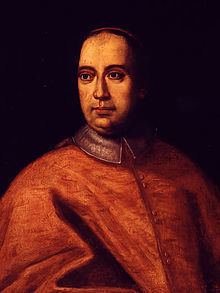Name Benedetto Pamphili Role Cardinal | Aunts Costanza Pamphili | |
 | ||
Died March 22, 1730, Rome, Italy Parents Camillo Francesco Maria Pamphili Grandparents Olimpia Maidalchini, Pamphilio Pamphili | ||
Il violoncello del cardinale, with l'Accademia Ottoboni and Marco Ceccato
Benedetto Pamphili (often with the final long i orthography, Pamphilj) (25 April 1653 – 22 March 1730) was an Italian cardinal, patron of the arts, composer and librettist.
Contents
- Il violoncello del cardinale with lAccademia Ottoboni and Marco Ceccato
- COSTANZI Sinfonia a violoncelle solo in D Major WD 551 III Amoroso by Accademia Ottoboni
- Life
- Patronage
- Works libretti and scores
- References
COSTANZI // Sinfonia a violoncelle solo in D Major WD 551: III. Amoroso by Accademia Ottoboni
Life
Pamphili was born in Rome on 25 April 1653 into the powerful Pamphili family. His father was Camillo Pamphili who had also been a cardinal but renounced his post to marry Olimpia Aldobrandini.
Pamphili was Grand Prior of the Order of St John of Jerusalem in Rome from 1678 until Pope Innocent XI made him cardinal-deacon of Santa Maria in Portico in the consistory of 1 September 1681.
He later opted for the tituli of Sant'Agata in Suburra, San Cesareo in Palatio, Santa Maria in Cosmedin and Santa Maria in Via Lata.
Innocent X made him Prefect of the Apostolic Signatura on 23 March 1685. He became Cardinal Legate of Bologna in 1690, cardinal protodeacon in 1693, as well as archpriest of the basilica of Santa Maria Maggiore and of San Giovanni in Laterano.
In 1704 he was made librarian of the Biblioteca Apostolica Vaticana and archivist of the Archivio Segreto Vaticano. He died in 1730 and is buried at Sant'Agnese in Agone.
Patronage
He was in the first rank of Rome's cultural and artistic life in the 17th and 18th centuries, as demonstrated by his belonging to the prestigious accademia dell'Arcadia, under the pseudonym Fenicio Larisseo. He formed the major collection of Flemish paintings in the Galleria Doria Pamphilj, whose interior (by Carlo Fontana) and chapel he had built.
He was particularly interested and skilled in music, not only writing several libretti himself for operas with music by (among others) Alessandro Scarlatti, but also gave hospitality and opportunity to several composers (such as Arcangelo Corelli, Giovanni Lorenzo Lulier, Alessandro Melani, Antonio Maria Bononcini and Carlo Francesco Cesarini, who all began their musical careers under his protection), funding publication and performances of their works. His patronage was also expressed during George Frideric Handel's stay in Rome, when he struck up a lasting friendship with the composer and began an interesting correspondence with him. Handel dedicated a series of cantatas to the cardinal, as well as the famous 1707 oratorio Trionfo del tempo e del disinganno, with a libretto by the cardinal.
